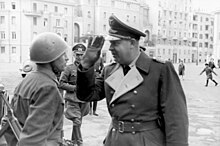Kurt Mälzer
Kurt Mälzer (born August 2, 1894 in Altenburg , † March 24, 1952 in Werl ) was a German lieutenant general in the Air Force . As commandant of Rome, he was jointly responsible for the massacre in the Ardeatine Caves in 1944 . He was sentenced to death in 1946 for war crimes , but was pardoned to life imprisonment and died in the Werl prison before his release .
Life
In 1914, before the outbreak of the First World War, Mälzer joined the Saxon army as a flag junior . In the same year he was awarded the Iron Cross 2nd and 1st class. He also completed pilot training during the war. After the end of the war he was accepted as a lieutenant in the Reichswehr and initially served as a platoon leader in the 4th motor vehicle department. In 1923/24 he completed an apprenticeship at the Jüterbog artillery school . Promoted to first lieutenant in 1925 , he became battery chief in the 4th Artillery Regiment . Between 1928 and 1933 he was assigned to study at the Technical University of Charlottenburg , where he graduated in 1933 with a degree in engineering . He was then delegated to the Ministry of Defense .
In 1934, Mälzer moved to the Luftwaffe, which was being rebuilt. He briefly taught at the technical school in Jüterbog and was one of the first trainers at the new air technology academy in Berlin-Gatow . In 1937, he was now in the rank of lieutenant colonel, commander of Kampfgeschwader 255 and commander of the Landsberg am Lech air force base .
At the beginning of the Second World War , Mälzer was assigned to the staff of Luftflotte 2 . During the French campaign , Mälzer was on May 28, 1940 commander of the Luftgaukommando Belgium-Northern France in Brussels. Promoted to major general in 1941 , he was head of department in the Reich Ministry of Aviation in 1942/43, and in September 1943 he became the commander of medical flight readiness 17 in Vienna. Promoted to Lieutenant General on October 1, 1943, he was transferred to Rome as city commander on October 30, 1943. As such he was subordinate to Eberhard von Mackensen .
In his capacity as city commander he was one of those responsible for the massacre in the Ardeatine Caves . Since Rome was considered a city close to the front, the decision-making power over retaliatory measures after attacks on German soldiers lay with the commanders of the Wehrmacht , i.e. with Mälzer, Mackensen and Field Marshal Albert Kesselring . The head of the SD in Rome, Herbert Kappler , was subordinate to Mälzer. When a bomb attack on German soldiers was carried out on March 23, 1944 in Via Rasella, Mälzer, who was also referred to by Mackensen on other occasions as a “confused head”, ordered the residential district in Via Rasella in after arriving at the scene of the crime to blow up. However, the officer who took this order forbade the demolition on behalf of Field Marshal Kesselring. Together with Kappler and Kesselring, Mälzer decided, ostensibly to carry out an order from Adolf Hitler , to shoot ten hostages for every German killed. A total of 335 Italian civilians, political prisoners and Jews were killed on March 24, 1944.
Mälzer was charged with this war crime together with Mackensen in November 1946 before a British military court in Italy and sentenced to death. In September 1946, an American military tribunal had already sentenced Mälzer to ten years in prison for the public display of prisoners of war during a parade in Rome on February 2, 1944, a sentence that was reduced to three years. On June 29, 1947, Mälzer and Mackensen were pardoned to life imprisonment. The British justified this with the fact that Kesselring would not have been sentenced to death in an Italian court. Mackensen and Mälzer had been serving their sentences in Werl prison since 1947. While Mackensen was released in October 1952, Mälzer died in prison. His funeral was turned into a solidarity rally by the Association of German Soldiers , which was also joined by the German Red Cross , the Stahlhelm, Bund der Frontsoldaten , the FDP and Die Falken .
literature
- Joachim Staron: Fosse Ardeatine and Marzabotto. German war crimes and resistancea. History and national myth-making in Germany and Italy (1944–1999) . Schöningh, Paderborn 2002, ISBN 3-506-77522-7 .
Individual evidence
- ↑ Staron, Fosse Ardeatine , pp. 51-53, 139.
- ↑ TRIAL OF GENERAL OF MACKENSEN AND GENERAL Mälzer BRITISH MILITARY COURT, ROME, 18TH-30TH NOVEMBER 1945
- ^ "Tried by a US military court at Florence, Italy, and sentenced to 10 years imprisonment on September 14, 1946 (7 years remitted), for parading US prisoners of war through the streets of Rome" History of the United Nations War Crimes Commission and the Development of the Laws of War. United Nations War Crimes Commission. London: HMSO, 1948
- ↑ Filippo Focardi: The calculation of the "boomerang". Politics and legal issues in dealing with German war crimes in Italy. In: Norbert Frei (ed.): Transnational politics of the past. How to deal with German war criminals in Europe after the Second World War. Wallstein, Göttingen 2006, pp. 545, 558.
- ↑ Bert-Oliver Manig: The politics of honor. The rehabilitation of professional soldiers in the early Federal Republic. Göttingen 2004, p. 456
| personal data | |
|---|---|
| SURNAME | Maltster, Kurt |
| BRIEF DESCRIPTION | German Lieutenant General in the Air Force |
| DATE OF BIRTH | August 2, 1894 |
| PLACE OF BIRTH | Altenburg |
| DATE OF DEATH | March 24, 1952 |
| Place of death | Werl |
